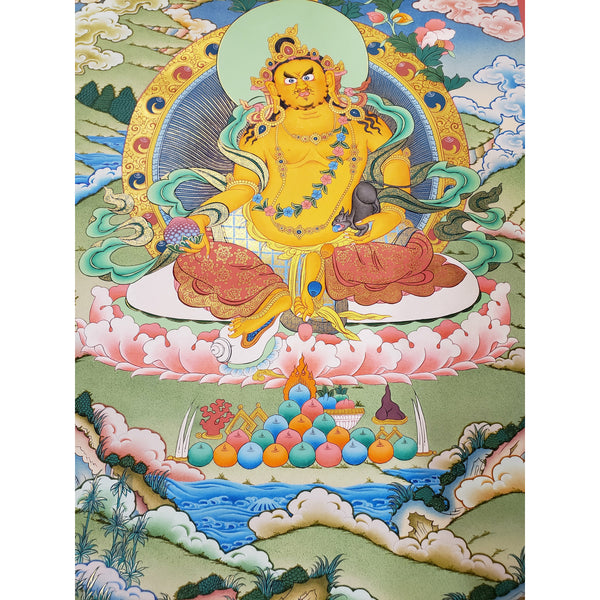Kubera Masterpiece Tibetan Thangka Painting
CHRISTMAS SALE
Get it between - .

Tibetan Thangka painting depicting Kubera is perfect for various home décor ideas! This 100% hand-drawn Thangka painting made in Kathmandu Valley, Nepal can be decorated as an elegant and eccentric wall hanging in your home or office being a centrepiece of attention. It can also be placed on your family altar for meditation purposes as well as spiritual and emotional healing, attracting benevolent energy of the Tibetan Buddhist art.
Specification
- Dimensions: 82 x 59 cm
- Materials: Tibetan Gold Dust and Tibetan Colors mixed with Hide Glue
- Canvas: Organic Cotton
- Hand Painted in Nepal
Kuber as Jambhala
In Buddhism, Jambhala is known as the god of wealth and good fortune. Jambhala is also known as Vaishravana, the popular god of wealth in Hindu Mythology and holds a strong resemblance to the Hindu deity Kubera. Vaisravana is translated as the “Son of Fame”.
Kubera is the lord of wealth and guardian of the Northern Direction. According to the Hindu mythology, he is said to have performed austerities for a thousand years, in regard for which Brahma gave immortality and made him the god of wealth, guardian of all treasures of the earth which he has to distribute according to the destiny of the receivers. Kubera’s dwelling place was said to be on Klaka in the Himalayas, abounding in wealth and magnificent. Kubera is also worshipped by Buddhist.
Jambhala is a wealth deity whose blessings remove the obstacle of poverty, bringing wealth and abundance to pure Dharma practitioners. As it is difficult to attain spiritual realizations while afflicted by lack of resources, Jambhala generates prosperity so that practitioners have the time, energy, and means to accomplish.
Story Behind Jambhala
According to the Sutras, while Shakyamuni Buddha was teaching one day, demons tried to disturb and confuse the Buddha.
Jambhala appeared in front of the Buddha and protected him. Recognizing Jambhala’s courageous action, the Buddha asked Jambhala if he would like to become a Dharma Protector in order to help all sentient beings.
Jambhala god accepted the Buddha’s offer, and since then he has offered immediate assistance to all who call his name or chant his mantra. His blessings bestow good luck, increase virtues, prolong life, increase intelligence, and provide both material and spiritual benefits.
Jambhala is the lord of He is the emanation of Buddha Ratnasambhava. He can remove poverty from the six realms, increasing virtues, lifespan, and wisdom.
The mantra of Yellow Jambhala: Om Djambhala Djardin Djaya Soha
Each day recite his mantra 108 times to get benefited from this mantra.
Gesture and attributes
There are five Jambhalas commonly called as
- Yellow Jambhala
- White Jambhala
- Black Jambhala
- Green Jambhala
- Red Jambhala
Yellow Jambhala is the most common form. Each form has its own special significance and attributes.
Yellow Jambhala is depicted adorned with a crown, silk garments, and beautiful gold and jeweled ornaments. He is seated imperially upon a throne, with abijapuraka fruit in his right hand and a mongoose in his left hand. The mongoose constantly spews forth precious jewels and treasures and represents Jambhala’s victory over the nagas.
In this painting is Kubera is sitting on a white snow lion is the presiding deity of. The snowy mountain ranges in the painting illustrate the snowy range from covering Tibet to Nepal.
The white lion is the national animal of Tibet and adorns the Tibetan national flag, as also the insignia of the Dalai Lama himself. The giant figure or healthy looks of Namthose is golden yellow in color and has a stern expression.
He holds a banner of victory in his right hand while the left arm holds a mongoose, an animal which is truly associated with good fortune.
On the top left side of the painting, we can see Shakyamuni Buddha and button left side we can see the small picture of Kubera. Buddha gave the power of wealth to god Jambhala.
Jambhala god of wealth is known as dharma protector.
You can find answers to common questions on our FAQ page here.
View all our shop reviews at reviews page here.









